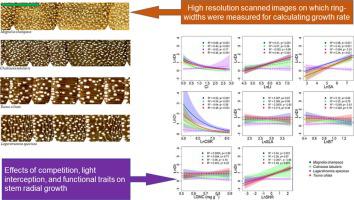Forest Ecology and Management ( IF 3.7 ) Pub Date : 2021-01-18 , DOI: 10.1016/j.foreco.2020.118908 Mizanur Rahman , Masum Billah , Md Obydur Rahman , Debit Datta , Muhammad Ahsanuzzaman , Mahmuda Islam

|
Tropical forests have been focused for mitigating climate change impact through carbon sequestration in plant biomass under clean development mechanism (CDM). Since trees represent more than 98% of the above ground plant biomass, variation in tree growth rate drives carbon dynamics in tropical forests. By using tree-ring analysis, trait-based measurements, and field observations, we aimed at understanding the drivers of growth rate variation in four South Asian tropical moist forest tree species varying in plant functional types. Principal component analysis (PCA) revealed that mainly demographic and wood traits represented the first axis explaining 37% of the variance, whereas the second axis was represented by the leaf traits. Stem growth rate (DI) showed a nonlinear negative relation with competition index (CI) and the ratio of crown surface area to basal area (CBR) in three out of four tree species (p < 0.001) except Lagerstroemia speciosa which showed no significant relationship with any of the studied variables. DI was linearly positively related with light interception index (LI) and the ratio of sapwood area to heartwood area (SHR) in the shade intolerant Magnolia champaca and Toona ciliata (p < 0.001). Sap wood area (SA) had a strong positive effect on DI in the three species (p < 0.001). Taking tree size as a random factor and thus accounting for ontogenetic effects on tree growth, linear mixed effect modelling revealed that CI, SA and SHR are the best predictors of DI in M. champaca (AIC = 25.81, R2m = 0.81) and T. ciliata (AIC = 62.95, R2m = 0.61). In C. tabularis, CI, SA and CBR included in the best model predicting DI (AIC = 94.62, R2m = 0.55). Variance partitioning analysis showed that the highest pure effect was observed in C. tabularis contributed by CI (12%), while the highest joint effect was found in M. champaca contributed by CI, SA and SHR (40%). Our analyses suggest that competition by neighbouring trees especially for soil moisture and the amount of active xylem portion are the main drivers of tree growth in moist tropical forests. Since tree growth rates regulate forest carbon dynamics, the insights into the growth drivers of the four selected species revealed by the study have important implications for forest/plantation management with a focus on carbon storage under CDM.
中文翻译:

弄清竞争,光拦截和功能性状在南亚热带湿润森林树木生长速率变化中的作用
在清洁发展机制(CDM)下,热带森林一直致力于通过碳固存植物生物量来缓解气候变化的影响。由于树木占地面植物生物量的98%以上,树木生长速率的变化驱动热带森林的碳动态。通过使用树木年轮分析,基于特征的测量和现场观察,我们旨在了解植物功能类型不同的四种南亚热带湿润林木树种生长速率变化的驱动因素。主成分分析(PCA)显示,主要人口统计和木材特征代表第一个轴,解释了37%的方差,而第二个轴则由叶子特征表示。紫薇菌与任何研究变量均无显着关系。在不耐荫的木兰和香椿中, DI与遮光指数(LI)和边材面积与心材面积之比(SHR)呈线性正相关(p <0.001)。边材林面积(SA)对这三个物种的DI有很强的积极作用(p <0.001)。以树木大小为随机因素,并由此考虑对树木生长的遗传影响,线性混合效应模型显示,CI,SA和SHR是香蒲中DI的最佳预测因子(AIC = 25.81,R 2 m = 0.81)和T.纤毛(AIC = 62.95,R 2 m = 0.61)。在C. tabularis中,CI,SA和CBR包括在预测DI的最佳模型中(AIC = 94.62,R 2 m = 0.55)。方差划分分析表明,CI引起的板状念珠菌的纯净效果最高(12%),而champaca属的最高联合效果最高。由CI,SA和SHR贡献(40%)。我们的分析表明,邻近树木的竞争,特别是土壤水分和活性木质部部分的竞争,是潮湿热带森林树木生长的主要驱动力。由于树木的生长速度调节着森林的碳动态,因此该研究揭示的对四个选定物种的生长驱动力的见解对于森林/人工林管理具有重要的意义,其重点是CDM下的碳储存。











































 京公网安备 11010802027423号
京公网安备 11010802027423号